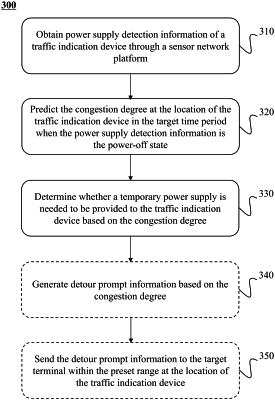| CPC G06F 1/26 (2013.01) [B64C 39/024 (2013.01); G08G 1/0133 (2013.01); G08G 1/0145 (2013.01); G08G 1/095 (2013.01); B64U 50/19 (2023.01); B64U 2101/00 (2023.01); B64U 2201/10 (2023.01)] | 5 Claims |

|
1. A method for traffic management in a smart city based on Internet of Things (IoT), implemented in a traffic management platform, the method comprising:
obtaining power supply detection information of a traffic indication device through a sensor network platform, comprising:
accessing an object monitoring platform through the sensor network platform, and obtaining the power supply detection information of the traffic indication device detected by a power supply detection device from the object monitoring platform;
predicting a congestion degree at a location of the traffic indication device in a target time period when the power supply detection information is a power-off state comprising:
obtaining location information of the traffic indication device; and
determining the congestion degree at the location of the traffic indication device in the target time period by processing, based on a prediction model, the location information, wherein
the prediction model is a Graph Neural Network (GNN) and the determining the congestion degree at the location of the traffic indication device in the target time period by processing, based on a prediction model, the location information, comprising:
processing graph data based on the prediction model to determine a predicted value of the congestion degree of at least one node in the graph data in the target time period; wherein the graph data include a plurality of nodes and a plurality of edges/paths connecting a plurality of nodes, characteristics of the at least one node include a count of vehicles passing through an intersection, and characteristics of the plurality of edges include intersections at both ends of road, road direction, and road length;
processing a monitoring video of the intersection obtained by a camera device based on a traffic volume determination model to obtain a traffic volume in all directions of the intersection, wherein the traffic volume determination model includes a convolutional neural network (CNN) and a recurrent neural network (RNN);
processing the monitoring video of the intersection based on the CNN to obtain image characteristics of each video frame when the monitoring video of the intersection is input into the traffic volume determination model;
inputting the image characteristics of each video frame into the RNN; and
determining the traffic volume of the intersection based on the image characteristics of each video frame in each direction through the RNN; and
determining whether a temporary power supply is needed to be provided to the traffic indication device based on the congestion degree.
|